Abbasid Jumeirah, Dubai. An Overview of the Site and Its Architectural Stucco Decoration
DOI:
https://doi.org/10.12775/EtudTrav.36.003Słowa kluczowe
Jumeirah, Islamic archaeology, Islamic architecture, stucco, Abbasid period, eastern ArabiaAbstrakt
Jumeirah (Dubai) is one of the most important sites for the understanding of the Abbasid period in eastern Arabia. At the same time, it is severely understudied and the small number of publications available on the subject situates Jumeirah on the margins of academic debate about the region in the Islamic period. This paper aims to prompt discussion on Jumeirah by presenting an overview of the site, a summary of archaeological research and a preliminary study of the typology of stucco decorations. Some issues regarding problems with the reconstructions and renovations of the buildings are also raised. The study of stuccoes contributes to a better understanding of the site’s chronology, indicating its main phase of occupation to the Abbasid period and the possible existence of an earlier, pre-ninth or early ninth century phase.
Bibliografia
Al-Zubarah Archaeological Site: https://qatarmuseumsstorageprd.blob.core.windows.net/media/documents/Al_Zubarah_Visitor_Guide_EN_Nov_22.pdf (accessed November, 2023)
Arce, I. 2001: The Early Islamic Stucco Techniques and the Partho-Sasanian Tradition. Continuity and Change, [in:] Biscontin, G., Driussi, G. (Eds), Lo Stucco. Cultura, Tecnologia, Conoscenza. Atti del convegno di studi. Bressanone 10–13 luglio 2001, Scienza e Beni Culturali 17, Venezia, 107–123
Arce, I. 2007: Umayyad Building Techniques and the Merging of Roman-Byzantine and Partho-Sasanian Traditions: Continuity and Change, [in:] Lavan, L., Zanini, E., Sarantis, A. (Eds), Technology in Transition A.D. 300–650, Late Antique Archaeology 4, Leiden, 491–538
Baramki, D.C. 1975: An Ancient Caravan Station in Dubai, ILN 2903, 66
Berti, M. 2016: Conservation of coral stone architectural heritage on the coast of East Africa, Conservation of Architectural Heritage (CAH), Procedia – Social and Behavioral Sciences 225, 47–56
Bloom, J.M., Blair, S.S. 2009: The Grove Encyclopedia of Islamic Art and Architecture, Vol. 3, Mosul-Zirid-New York
Carter, R. 2008: Christianity in the Gulf during the first centuries of Islam, AAE 19, 71–108
Corsi, A.L. 2018: A Stucco Merlon from the Congregational Mosque of Siraf at the British Museum, VicOr 22, 153–162
Creswell, K.A.C. 1940: Early Muslim Architecture: Umayyads, early ʿAbbāsids & Ṭūlūnids, Vol. 2, Early ʿAbbāsids, Umayyads of Cordova, Aghlabids, Ṭūlūnids, and Samānids, A.D. 751–905, Oxford
Dubai Municipality Excavations Report 2007: Al-Tanqībāt al-atharīyya fī maūqiʿ Jumayrā, al-tall raqm 10. Taqrīr awwalī/al-mawsim al-awwal. Imārat Dubay. Al-Imārāt al-ʿArabīyya al-Muttaḥida. Min shahr fabrāyīr ilā shahr ibrīl 2007. Dāʾirat al-siyāḥa wa-l-taswīq al-tijārī. Qism al-āthār
Dubai Municipality Excavations Report 2008: Al-Tanqībāt al-atharīyya fī maūqiʿ Jumayrā, al-tall raqm 10. Taqrīr awwalī/al-mawsim al-awwal. Imārat Dubay. Al-Imārāt al-ʿArabīyya al-Muttaḥida. Min shahr 21 yanāyīr ilā shahr 30 ibrīl 2008. Dāʾirat al-siyāḥa wa-l-taswīq al-tijārī. Qism al-āthār
Hamilton, R.W. 1953: Carved Plaster in Umayyad Architecture, Iraq 15/1, 43–55
Hardy-Guilbert, C. 2003: Les fragments de stucs décoratifs, [in:] Steve, M.-J. (Ed.), L’Ile de Khārg : une page de l’histoire du Golfe persique et du monachisme oriental, Civilisations du Proche-orient, série 1, Archéologie et Environnement, Vol. 1, Neuchâtel, 121–130
Hawker, R.W. 2006: Tribe, house style, and the town layout of Jazirat al-Hamra, Ras al-Khaimah, UAE, PSArabStud 36, 189–198
Hawker, R.W. 2008: Traditional Architecture of the Arabian Gulf. Building on Desert Tides, Southampton
Herzfeld, E. 1923: Das Wandschmuck der Bauten von Samarra und seine Ornamentik, Berlin
Insoll, T., Carter, R., Almahari, S., MacLean R. 2021: Excavations at Samahij, Bahrain, and the Implications for Christianity, Islamisation, and settlement in Bahrain, AAE 32/S1, 395–421
Jumeirah Plaster Analysis: www.platre.com/caseStudy/Old_Dubai_Jumeirah_plaster/en (accessed April 25, 2023)
Kennet, D. 2007: The decline of eastern Arabia in the Sasanian period, AAE 18, 86–122
Kennet, D. 2012: Archaeological History of the Northern Emirates in the Islamic Period: an outline, [in:] Potts, D., Hellyer, P. (Eds), Second International Conference on the Archaeology of the UAE. Abu Dhabi March 2009, Abu Dhabi, 189–201
King, G.R.D. 1997: A Nestorian Monastic Settlement on the Island of Ṣīr Banī Yās, Abu Dhabi: A Preliminary Report, BSOS 60/2, 221–235
Lic, A. 2017: Chronology of stucco production in the Gulf and southern Mesopotamia in the early Islamic Period, PSArabStud 47, 151–162
Lic, A. 2023: The Beribboned Cross in Christian Art of the Early Islamic Period in Iraq and the Gulf, BEO 68, 291–304
Lic, A. forthcoming a: Stucco decorations discovered in the monastic church of al-Qusur on Failaka island, Kuwait, [in:] Bonnéric, J. (Ed.), Al-Qusur, a Christian Settlement from the Early Islamic Period on Failaka, Vol. 1. Excavations of the French-Kuwaiti Archaeological Mission in Failaka (2011–2018), Kuwait City
Lic, A. forthcoming b: Stucco Decorations of the Church on Sir Bani Yas Island and their Artistic Context, [in:] McClary R.P. (Ed.), Stucco in the Islamic World: Studies of Architectural Ornament from Spain to India, Edinburgh
Power, T. 2018: The Role of Indian Ocean Trade Inland: The Buraimi Oasis, [in:] Fromherz, A.J. (Ed.), The Gulf in World History: Arabian, Persian and Global Connections, Edinburgh, 219–235
Priestman, S. 2021: Ceramic Exchange and the Indian Ocean Economy (AD 400–1275), British Museum Research Publications 223, London
Qandil, H. 2003: Recent Discoveries at Jumeirah, [in:] Potts, D.T., al-Naboodah, H., Hellyer, P. (Eds), Archaeology of the United Arab Emirates: Proceedings of the First International Conference on the Archaeology of the U.A.E, London, 318
Whitehouse, D., Whitcomb, D.S., Wilkinson, T. 2009: Siraf: History, Topography and Environment, London
Pobrania
Sklep wydawnictwa:
Opublikowane
Jak cytować
Numer
Dział
Licencja
Prawa autorskie (c) 2023 Instytut Kultur Śródziemnomorskich i Orientalnych PAN

Utwór dostępny jest na licencji Creative Commons Uznanie autorstwa 4.0 Międzynarodowe.
Statystyki
Liczba wyświetleń i pobrań: 316
Liczba cytowań: 0



